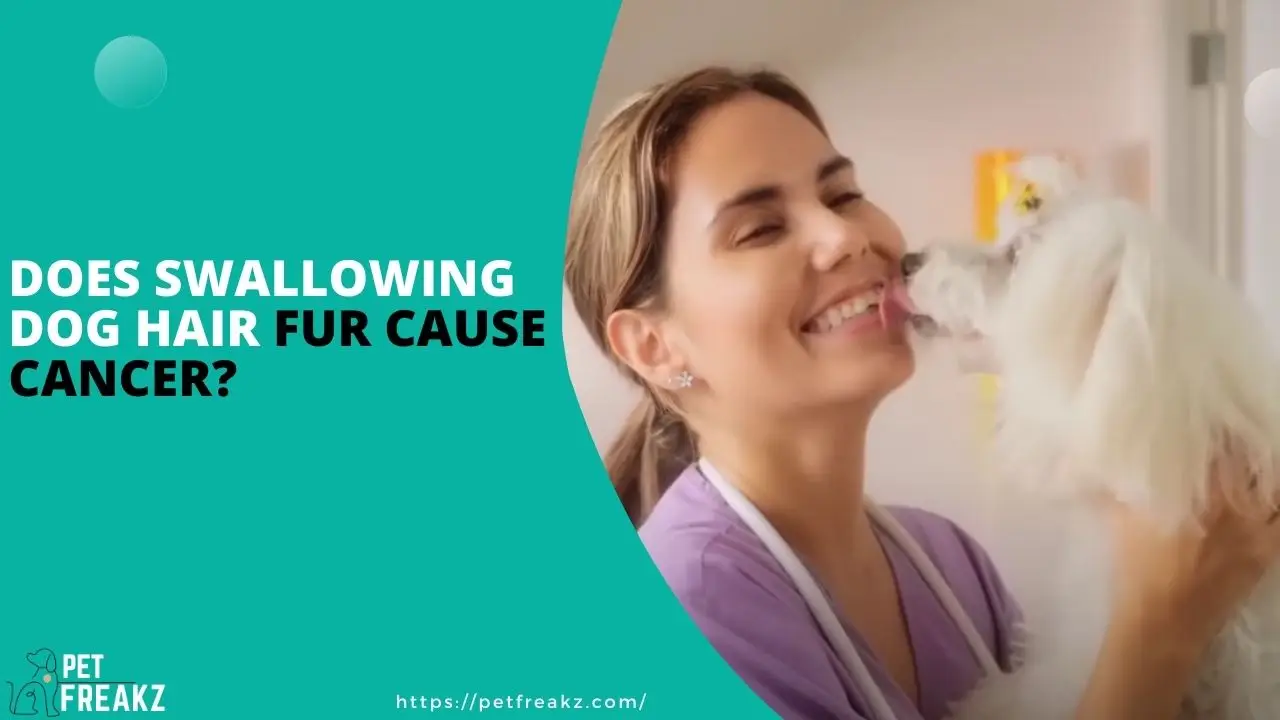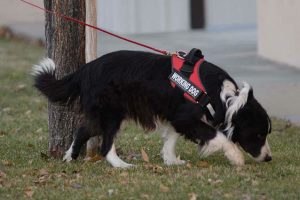No, swallowing dog hair fur does not cause cancer. Although swallowing dog hair fur is generally harmless, it may cause digestive discomfort in some individuals.
As pets shed their fur, it is not uncommon for people to accidentally consume a small amount of hair. This is usually passed through the digestive system without any issue. However, if a large amount of hair is consumed or if it forms a hairball in the digestive tract, it could lead to blockages or other complications.
If you have concerns about swallowing dog hair fur or experience any unusual symptoms, it is advisable to consult a healthcare professional for proper evaluation and guidance.
Table of Contents
Understanding The Link Between Swallowing Dog Hair Fur And Cancer
When it comes to our furry friends, it’s only natural to wonder about the potential risks associated with their hair. Many pet owners have concerns about the health implications of swallowing dog hair fur, particularly when it comes to the development of cancer.
In this section, we will examine the relationship between swallowing dog hair fur and the risk of cancer. Let’s dive in and analyze the role of dog hair fur in cancer development, the potential risks involved, and the findings of research studies investigating this connection.
The Role Of Dog Hair Fur In Cancer Development
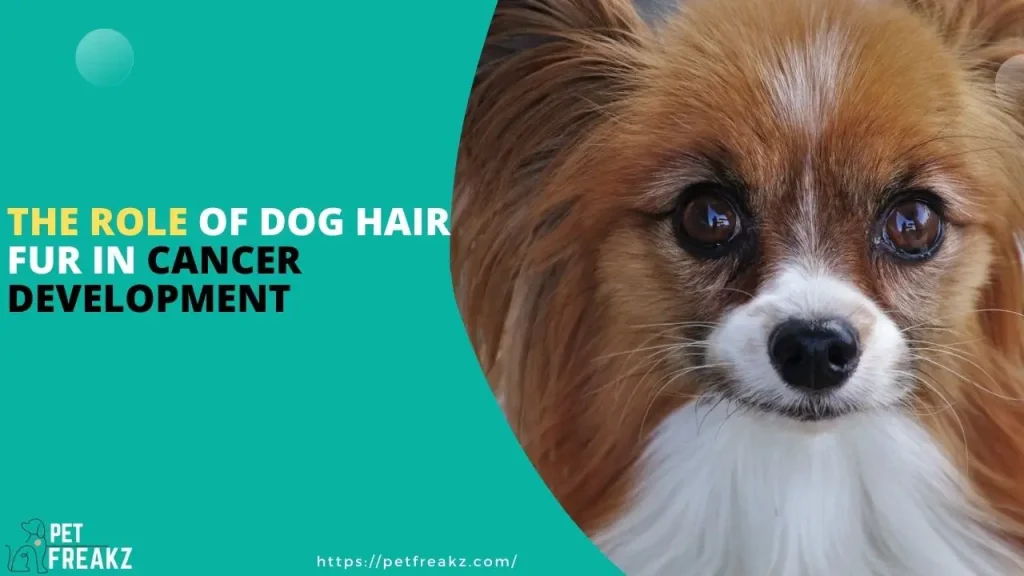
- Swallowing dog hair fur does not directly cause cancer. Cancer is a complex disease that typically develops due to a combination of genetic, lifestyle, and environmental factors.
- The ingestion of dog hair fur can potentially contribute to cancer development through indirect mechanisms, such as irritation or inflammation in the gastrointestinal tract. However, it’s important to note that these cases are relatively rare and highly dependent on various individual factors.
- Cancer typically arises from genetic mutations that occur within our own cells, rather than external factors like swallowing dog hair fur.
Is swallowing dog hair harmful?
- Swallowing small amounts of dog hair fur is unlikely to pose any significant health risk. Our digestive system is designed to handle and eliminate foreign materials, including small particles of hair.
- However, excessively ingesting large amounts of dog hair fur could potentially lead to gastrointestinal blockages in rare cases. This typically occurs when hair accumulates and forms a mass in the stomach or intestines.
- Certain breeds with longer hair or shedding tendencies may increase the risk of ingesting more significant amounts of fur. Pet owners should be vigilant in grooming and regularly cleaning their pet’s living environment to minimize the amount of loose hair present.
Effects of dog hair on the stomach
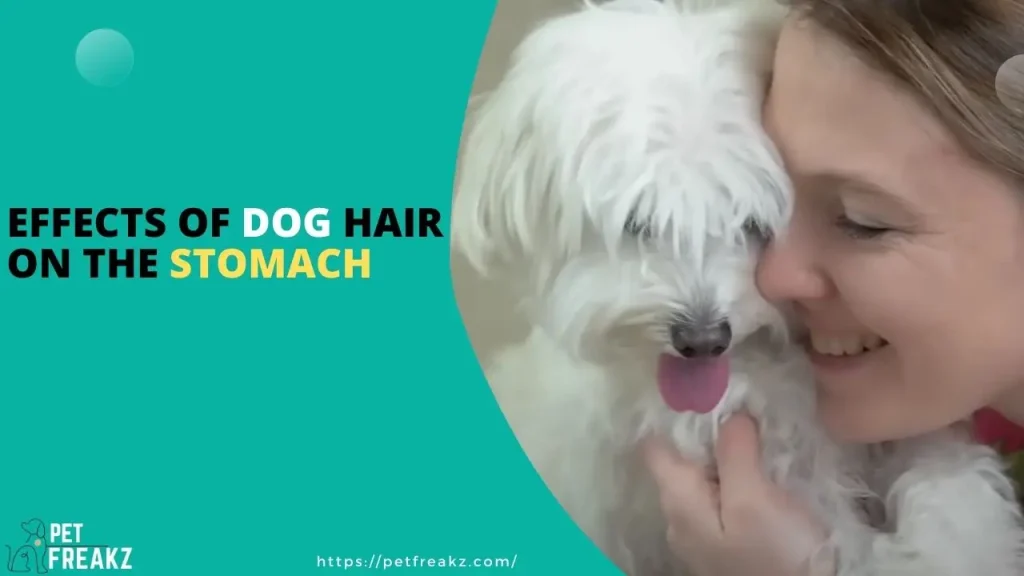
If you accidentally consume a small amount of dog hair and experience no discomfort or adverse effects, there’s likely no cause for concern. However, if you notice any unusual symptoms after ingesting dog hair, such as persistent abdominal pain, vomiting, or changes in bowel movements, it’s crucial to seek medical attention.
Is dog hair dangerous If I inhaled?
In most cases, inhaling a small amount of dog hair is unlikely to cause serious health issues, as our respiratory system has natural defence mechanisms to filter out foreign particles. However, for some individuals, particularly those with allergies or asthma, inhaling dog hair can trigger adverse reactions.
Allergic Reactions
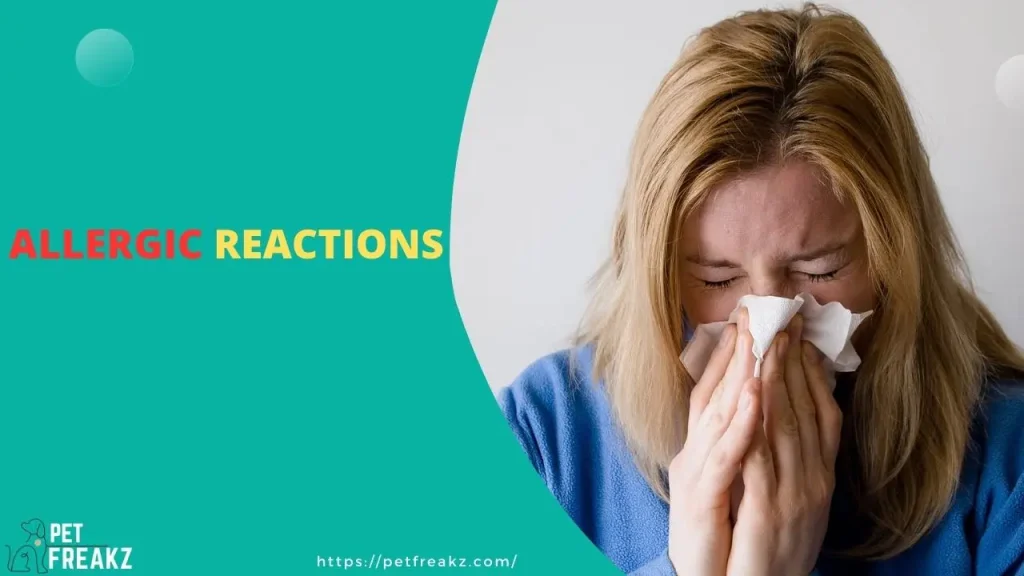
Individuals with allergies to pet dander, which includes dog hair, may experience sneezing, runny nose, itchy eyes, and skin irritation upon exposure. For them, inhaling dog hair can exacerbate these symptoms, making it uncomfortable to be around dogs.
Asthma Exacerbation
People with asthma may also find that inhaling dog hair can worsen their condition, leading to coughing, wheezing, chest tightness, and difficulty breathing. If you have asthma, it’s essential to manage your condition and avoid exposure to potential triggers like pet dander.
Research Studies On The Connection Between Dog Hair Fur And Cancer
- Limited research has been specifically conducted on the link between swallowing dog hair fur and cancer development. As a result, there is a lack of substantial evidence to support a direct causal relationship between the two.
- Some studies have investigated the potential health hazards of pet hair in general, focusing on allergies and respiratory conditions. These studies have mainly shown that individuals who are already prone to allergies or asthma may have increased sensitivities to pet hair, but the findings are not directly related to cancer development.
- More research is needed to comprehensively explore the impact of swallowing dog hair fur on cancer risk. Future studies may provide further insights into this topic, offering a clearer understanding of any potential associations.
Remember, as a responsible pet owner, it’s important to prioritize proper hygiene practices for both you and your furry companion. Regularly grooming your dog, vacuuming or cleaning areas where hair accumulates, and ensuring a balanced diet can help maintain your pet’s overall health.
While there’s no need to overly worry about the mere act of swallowing small amounts of dog hair fur, take necessary precautions to promote a safe and healthy environment for both you and your loyal four-legged friend.
Potential Health Issues From Swallowing Dog Hair Fur
We all love our furry friends and enjoy their company, but have you ever wondered if swallowing dog hair fur can have any negative health consequences? In this section, we will explore some potential health issues that can arise from ingesting dog hair fur.
While it’s natural for dogs to shed and for us to come into contact with their fur, it’s essential to be aware of the possible risks associated with swallowing it.
Diseases caused by dog hair
Allergies Caused by Dog Hair
Allergies occur when the immune system reacts to a foreign substance, known as an allergen, in an exaggerated manner. Dog hair, specifically the proteins found in a dog’s dander, saliva, and urine, can act as allergens for some individuals.
Respiratory Issues
In addition to allergies, dog hair can also exacerbate existing respiratory conditions, such as asthma. People with asthma may experience worsened symptoms when exposed to dog hair.
Skin Irritations Due to Dog Hair
Contact dermatitis can occur when a person’s skin comes into direct contact with dog hair. The irritation can lead to redness, itching, and discomfort.
Parasites
Dog hair can sometimes carry external parasites like fleas and ticks, which can cause additional health problems for both dogs and humans.
Dog Hair Cause Digestive Problems
When dog hair fur is swallowed, it can accumulate in the digestive system and form hairballs. These hairballs can cause various problems, such as:
- Intestinal blockages: Large hairballs may obstruct the digestive tract, leading to severe pain, vomiting, and even surgical intervention.
- Difficulty in passing stool: Smaller hairballs can still cause discomfort and difficulty in bowel movements.
It’s important to note that the above potential health issues are not common and usually occur in individuals who have a high sensitivity or are prone to allergies. However, it’s still advisable to take precautions and minimize the risks associated with swallowing dog hair fur.
Regular grooming, vacuuming, and maintaining good personal hygiene can help reduce the amount of loose hair and mitigate these potential health consequences.
So, next time you find yourself worrying about swallowing some dog hair fur, remember that while the risks are generally low, it’s always good to be aware of the potential health issues that can arise.
Preventive Measures: Reducing The Risk Of Swallowing Dog Hair Fur
Dogs are wonderful companions, but their shedding can be a nuisance. Besides the mess, it creates around your home.
To reduce the risk and ensure your well-being, it’s essential to implement preventive measures. Here are some suggestions for practical approaches to use:
Implementing Effective Grooming Practices For Your Dog
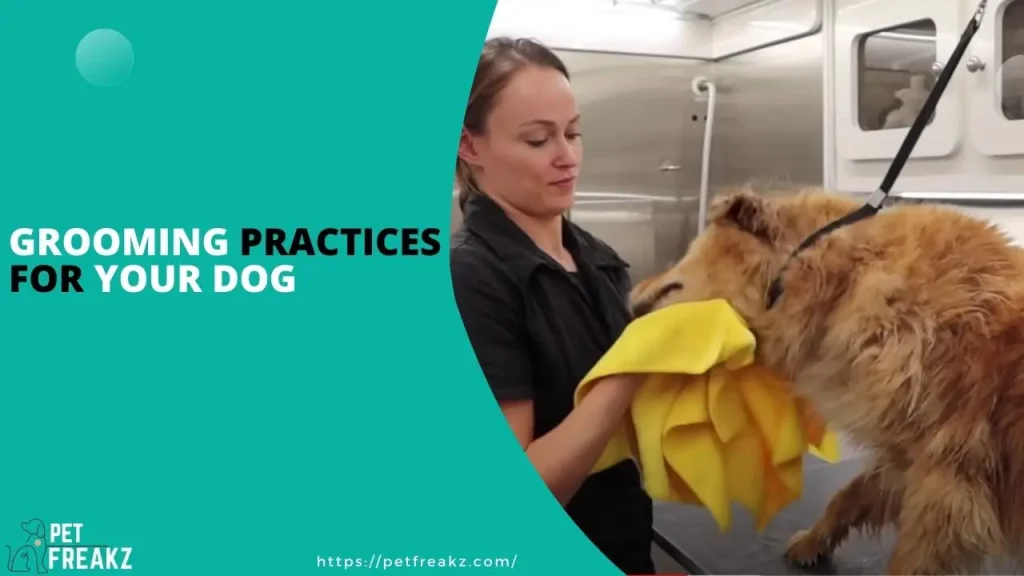
Proper grooming plays an important role in minimizing shedding and reducing the amount of loose hair your dog leaves behind. By adopting these practices, you can significantly contribute to reducing the risk of swallowing dog hair fur:
- Regular brushing: Brushing your dog’s coat daily helps to remove loose hair and prevents it from getting into your surroundings.
- Bathing routine: Establish a bathing schedule suitable for your dog’s breed and hair type. Regular baths keep the coat healthy and reduce excessive shedding.
- Professional grooming: Consider taking your furry friend to a professional groomer for regular maintenance. They have the expertise to give your dog thorough grooming and trim any excess fur.
Creating A Hygienic Environment To Minimize Hair Shedding
Maintaining a clean and hygienic environment plays a vital role in reducing the risk of swallowing dog hair fur. Here are some useful measures you can follow:
- Regular vacuuming: Vacuum your house on a regular basis, focusing on places where your dog spends most of their time. Pay special attention to carpets, rugs, and upholstery.
- Use lint rollers: Keep lint rollers handy to quickly remove loose hair from your clothes and furniture.
- Wash bedding regularly: Wash your dog’s bedding frequently to remove any trapped hair. Opt for pet-friendly detergents and ensure proper drying.
- Minimize access to certain areas: Consider restricting your dog’s access to certain areas of your home, such as bedrooms or areas with sensitive electronics to minimize hair accumulation.
Remember, while these preventive measures can help reduce the risk of ingesting dog hair fur, it’s always best to consult with your healthcare provider regarding any concerns related to your health.
Safe cohabitation with our furry friends requires staying vigilant and implementing preventive measures. Through proper grooming practices, maintaining a hygienic environment, and considering potential dietary modifications, you can minimize the risk of swallowing dog hair fur and enjoy a healthy and joyful companionship with your beloved dog.
Ensuring A Safe And Healthy Environment For Dogs And Their Owners
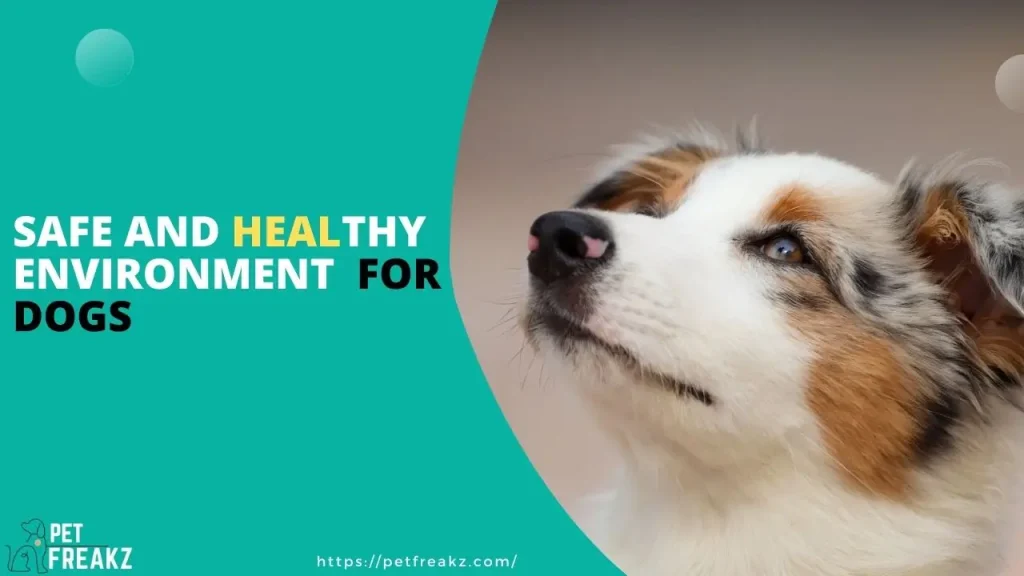
Swallowing dog hair fur is a common occurrence for dog owners. Whether it’s from grooming your furry friend or simply having them around the house, it’s hard to avoid those pesky hairs. But does swallowing dog hair fur pose any risks, particularly in relation to cancer?
Let’s delve into the topic and explore ways to ensure safe and healthful surroundings for owners and their dogs.
Importance Of Regular Veterinary Check-Ups And Preventive Care
Regular veterinary check-ups are crucial in maintaining your dog’s overall health and well-being. These visits allow veterinarians to assess your dog’s condition, identify any potential issues, and provide appropriate preventive care. Here are key points to consider:
- Regular check-ups enable early detection of any health problems, including potential complications related to swallowing dog hair fur.
- Preventive care measures, such as vaccination, parasite control, and annual bloodwork, can help safeguard your dog’s immune system and minimize the risks associated with ingesting hair fur.
- Veterinary professionals can provide tailored advice on grooming techniques and hair maintenance to reduce the amount of loose fur in your home.
By prioritizing regular veterinary check-ups, educating ourselves on the potential dangers of swallowing dog hair fur, and exploring alternative solutions for minimizing exposure to fur, we can ensure a safe and healthy environment for both dogs and their owners. Remember, while it may not cause cancer, taking proactive steps can help keep our beloved pets and ourselves in good health.
FAQs
Is Swallowing Dog Hair Fur Harmful?
Swallowing dog hair fur is generally harmless. The human digestive system is capable of breaking down small amounts of hair without any issues. However, a large quantity of dog hair can cause an obstruction in the intestines, which may require medical intervention.
It is important to keep an eye on the amount of hair being ingested and seek professional advice if necessary.
Does dog hair cause cancer?
No, swallowing dog hair fur does not cause cancer. Cancer is a complex disease caused by a variety of factors, including genetic mutations and environmental triggers. While it is never a good idea to consume large amounts of foreign objects, ingesting dog hair fur does not have a direct link to the development of cancer in humans.
What Happens if I Swallow Dog Hair?
If you accidentally swallow dog hair fur, there is no need to panic. The human body is designed to handle small amounts of foreign matter. However, if you experience any discomfort, such as abdominal pain or difficulty passing stools, it is advisable to consult a healthcare professional. They can assess your situation and provide appropriate guidance if needed.
Is dog hair dangerous for humans?
Dog hair itself is not typically harmful to humans. It might cause mild irritation or allergic reactions in some individuals, especially those who are allergic to pet dander. These reactions could include sneezing, itching, or nasal congestion.
Can dog hair kill you?
No, dog hair cannot kill you. In normal circumstances, dog hair is not toxic or deadly. However, if someone has an extremely severe allergy to dog hair, they might experience a severe allergic reaction called anaphylaxis. Anaphylaxis is a medical emergency and can be life-threatening if not treated promptly.
What happens if a baby swallowed dog hair?
If a baby swallows a small amount of dog hair, it is unlikely to cause any serious harm. The hair will likely pass through the digestive system without causing any issues. However, if the baby swallows a large amount of hair or experiences any symptoms like choking, difficulty breathing, or persistent vomiting after swallowing the hair, immediate medical attention should be sought.
What happens if dog hair goes into a human nose?
If dog hair gets into a human nose, it can be irritating and cause discomfort. In most cases, the body’s natural defence mechanisms will work to expel the hair through sneezing or by moving it down the throat to be swallowed.
Conclusion
To sum up, the question of whether swallowing dog hair fur causes cancer remains a topic of debate. While there is a possibility that ingesting large quantities of dog hair over a prolonged period may contribute to certain health issues, including digestive problems and intestinal blockage, there is currently no scientific evidence to support the claim that it directly causes cancer in humans.
That being said, it is still important to minimize the amount of dog hair that we swallow to avoid potential complications.
